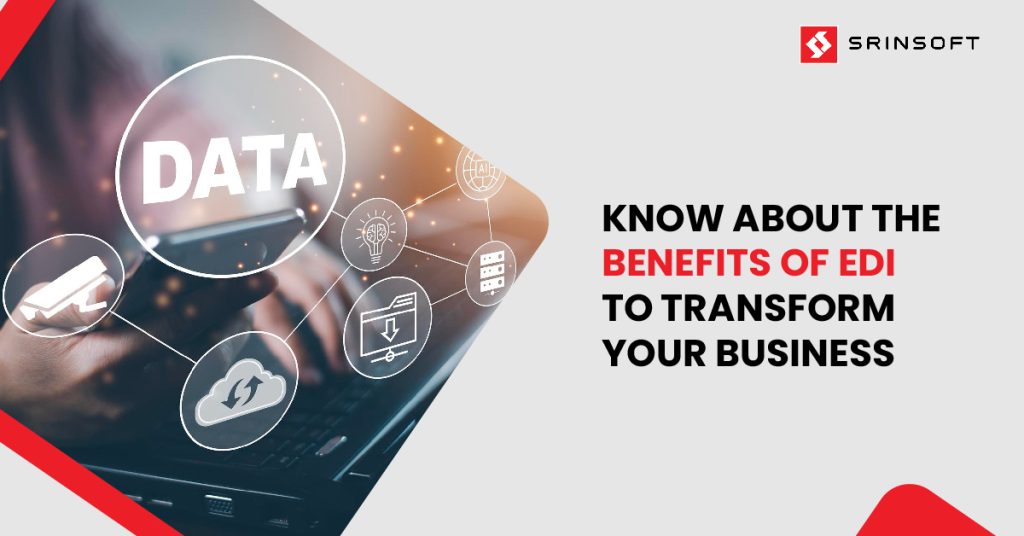
Introduction
With the advent of technology, companies have found efficient ways to exchange information and conduct transactions. It’s the late 20th century and businesses sought ways to improve efficiency and reduce errors. They relied on manual data entry and paper documents, which were time-consuming and prone to mistakes. The benefits of EDI helps to eliminate these challenges by offering faster and more reliable communication.
But, what benefits of EDI mean to a company is that they can integrate with their suppliers, customers, and logistics providers. EDI employs standardized electronic formats to securely transfer data, ensuring information flows accurately across systems without errors or delays.
Not only does this increase data sharing, but it also makes operations more efficient. Also, it strengthens the supplier-partner relationship by allowing everyone across the supply chain to track transactions in real-time.
In this article, we will take a comprehensive approach to highlight the many ways this technology benefits businesses and their operations.
For an efficient small business trying to automate its manual processes or a large enterprise aiming to streamline its supply chain, it is imperative they know the benefits that can be derived from EDI integration.
How Benefits of EDI can transform your business
We know that EDI drastically improves how businesses share information by replacing paper-based documents with electronic equivalents. This helps companies cut down lead times and enables them to enhance their operational performance.
Here are some of the key benefits offered by EDI that make it a necessity in today’s commerce.
How to leverage the benefits of EDI to improve efficiency
The Benefits of EDI automates the exchange of business documents which greatly expedites transactions while removing tedious human data entry and processing steps. This automation causes transactions to be a lot faster, has fewer errors, and enables employees to work on more strategic tasks.
Technically speaking, EDI encodes documents in standard formats (like ANSI X12 or EDIFACT) which are electronically exchanged between business partners.
These standards structure the data uniformly in a predefined way that helps to integrate with other internal systems like ERP (Enterprise Resource Planning) and CRM (Customer Relationship Management).
To further accelerate and automate this process, automated data mapping/translation tools can convert incoming EDI into the format of the internal application database – providing swift and fully automated access to necessary information without having it entered manually.
Improved Data Accuracy
Manual data entry is prone to errors which can lead to costly mistakes and operational disruptions. With the benefits of EDI, it is possible to greatly enhance data accuracy and ensure that information is delivered consistently and accurately among systems.
EDI helps prevent errors by using standard formats and gives all parties involved the same data. EDI itself ensures the purity of data through a variety of methods that include:
- Validation rules to verify the data based on predefined criteria before transmitting
- Reconciliation processes that cross-check sent and received documents to ensure consistency
These methods can identify and highlight errors like no fields or incorrect data type input that lies out of the valid range so that inaccurate data does not get into the system.
Additionally, they can automatically match and compare the documents you send back-and-forth to ensure they accurately represent an order or invoice.
Data accuracy is also improved thanks to error-handling protocols such as automatic error reporting and corrective actions that allowing quickly identify and resolve errors.
Strengthening Supplier and Partner Relationships
With benefits of EDI, trading partners can have an automated exchange of digital documents such as purchase orders, invoices and shipping notices.
This streamlining of the process can result in fewer delays and errors, which contributes to a faster supply chain as well as improves supplier-partner dynamics.
It also helps in the quick response for change by companies and hence help them keep operations running smoothly.
The real-time data exchange & integration solution from EDI helps companies streamline their supply chain activities.
The purchase order is automatically sent over to the supplier’s EDI system from where an acknowledgment and further processing of order takes place, without any human intervention.
Electronic notifications like advanced shipping notices (ASNs) can deliver detailed information on shipments to the receiving end of a supply chain, thereby greatly helping in preparing for deliveries.
It also helps in stock management by automatically updating inventory levels when a transaction happens which avoids out-of-stocks or over-stock situations.
EDI further supports just-in-time (JIT) inventory systems, as it helps in quick orders processing and fulfilment to keep lead times low while boosting the overall responsiveness of the supply chain.
How benefits of EDI saves cost and time
The main benefit of EDI is cost reduction. Since EDI automates the exchange of documents, it eliminates the need for paper-based documentation, printing letters for mails as well as the need for storing documents.
In addition, the speed of order fulfilment can be enhanced by faster transaction processing times resulting in an accelerated business cycle.
EDI reduces costs and saves time through several ways. Paper-based activities are eliminated, and businesses not only save money on the purchasing of paper to print but also reduce labour costs associated with handling, filing, and retrieving physical documents.
EDI is also a way to save on postage and courier services for sending physical documents in the mail. Electronic transactions can be processed more quickly than manual transactions, leading to faster order fulfillment and payment cycles.
By integrating with the enterprise financial systems, EDI can automate invoicing and payment processing, which cuts down on administrative overhead and speeds up cash flow.
Experience the benefits of EDI integration. Request a demo!
Scalability and Flexibility
One of the key benefits of EDI is scalability and flexibility. EDI can be expanded even on a large scale based on the demands of the organization. As companies grow or integrate new partners, EDI can manage more data volume and transaction complexity.
This agility enables companies to face newer challenges without disrupting the existing tech ecosystem.
The modular, extensible architectures in EDIs is the reason why the technology is scalable as well as flexible.
In many organizations, EDI solutions have customizable workflows that can be modified to meet the needs of new business processes and trading partners.
Middleware solutions that are cloud-based provide nearly unlimited scalability, permitting businesses to scale up for peak transaction volumes and down afterward without adding any new hardware investment.
EDI systems can also facilitate the use of a huge range of document types and standards, which simplifies the onboarding process with new partners.
Robust data mapping and transformation tools built into EDI enable integration with any internal system, so you can scale & connect your EDI infrastructure as your business grows.
Data Privacy and Security
EDI always ensures Data privacy and security, a major part of the benefit of EDI. EDI solutions make sure that information stays private and secure during transmission through many technical procedures.
The data sent through EDI is encrypted using secure algorithms like AES (Advanced Encryption Standard) which ensures the security of sensitive information while transmitting.
Digital signatures and multi-factor authentication can confirm the identity of users, thereby preventing unauthorized access. EDI systems manage access control to make sure that only appropriate staff can handle the data.
To prevent unauthorized interception on data exchange, EDI uses secure communication channels such as AS2 (Applicability Statement 2) and SFTP (Secure File Transfer Protocol).
The user requests and responses are channelled over these pathways, which creates secure and encrypted channels to protect against eavesdropping or fraud.
Moreover, EDI solutions offer real-time transaction monitoring and automated error detection mechanisms which promptly point out any abnormalities as well as discrepancies.
These security protocols in EDI help companies to ensure they have data integrity, compliance with regulators, protection against breach/fraud as well as maintain business continuity & trust.
Additionally, by adhering to stringent data privacy regulations such as GDPR or HIPAA, EDI helps companies avoid costly fines and reputational damage associated with non-compliance.
How benefits of EDI helps in reducing risk
In addition to reducing the risk of human error, another benefits of EDI is to safeguard data. Some EDI solutions offer 24/7 monitoring and redundant systems to catch any problems right away.
Giving access to a secure backup is essential in the event of catastrophic data loss, and it also keeps your business running.
In practice, EDI mitigates the risk in multiple ways through several security measures and best practices. Data confidentiality and integrity are established during EDI transactions as data is transmitted in a standardized format using encryption methods such as SSL/TLS.
EDI systems typically have extensive logging facilities to log all transactions and changes so that an audit trail can be reliably obtained on who has transmitted or modified data compliantly.
On top of that, EDI solutions use redundant failover mechanisms such as mirrored databases and backup servers to guarantee data availability even when the system is down. This reduces the risk of severe data loss and helps maintain business continuity.
Conclusion
EDI integration is a powerful tool that can significantly enhance business efficiency and competitiveness. Opting for EDI integration is one of those strategic moves that can change how businesses work. It automates tasks, improves data accuracy, deepens relationships and brings about cost savings.
EDI will remain important to modern business as technology advances, so companies should consider it as a secure way for data exchange as well as in a simple and reliable manner.
While EDI is convenient, it too comes with its challenges – namely dealing with setup costs, added overhead for technical support and ensuring compatibility with trading partners’ systems.
FAQs
What is one of the key advantages of an EDI?
EDI allows businesses to avoid manually logging into their customer’s trading portals. Instead, they can rely on a single electronic communication method to exchange orders, invoices and other EDI messages. In addition, automation delivers both time and financial savings.
What are the benefits of EDI in the supply chain?
The utility of EDI in the supply chain lies in its automation. By eliminating the need for paper-based processes and manual data entry, EDI reduces errors, speeds up transactions, and ensures that each link in the supply chain is continually updated with real-time data.
Who uses EDI?
EDI is widely used across various industries, including retail, manufacturing, healthcare, logistics, finance, and more. Its adaptability makes it suitable for any sector that engages in electronic data exchange with trading partners.
What are the key elements of EDI?
There are two key elements in basic EDI – First, electronic documents replace paper documents. Second, the exchange of documents takes place in a standardized format. Using these two basic concepts, any business can enter the world of EDI and begin taking advantage of the speed and economy of electronic commerce.








